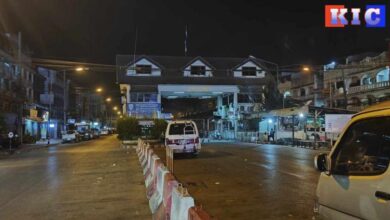Villagers fear Salween Dam

In spite of the devastation and loss of life caused by recent earthquakes in northern Thailand and northeast Burma government officials are pushing ahead with its plans to dam the Salween River.
The Thai government responded to the recent earth quake in northern Thailand by calling for ‘a meeting for key agencies’ to develop strategies to cope with future earthquakes.
The Thai government department’s attending the meeting on were those with responsibility for the countries civil defence, national safety and rescue operations. The meeting look at how to install effective early warning systems and what to do if there’s damage caused to hydro-power dams in the north and the west of the country.
On 14th March, to commemorate the 8th International Day of Action Against Dams, more than 300 Karen villagers took to the Salween River to protest against the Burmese government’s plan to build a hydroelectric dam on the river. The Burmese government has agreed to export power to Thailand and China.
An agreement signed in 2006 between Burma’s Ministry of Electric Power, Thailand’s Electricity Generating Authority of Thailand (EGAT) and China’s Sinohydro for the one billion USD project to start – it is expected to start feeding energy into the Thai power grid by 2019.
The 300 protesters – all directly affected by the Hatgyi Dam, gathered on the Salween’s banks to protest against the construction – passionately chanted their opposition to the project. Holding signs and banners the protesters shouted – ‘Salween Dam, we don’t want’, ‘Stop the dam on the Salween’ and ‘EGAT, get out’.
The protest took place at Wai Kyi on the Salween River where the three countries Burma, China and Thailand plan to build the Hatgyi dam.
The Salween River, Southeast Asia’s second longest river, flows 2,800kms down from the Tibetan Plateau. It twists its way through China, Shan and Karen states along the Thai Burma border before “emptying into the Andaman Sea in Burma’s territorial waters.” Karen River Watch, estimates as many as 10 million people from at least 13 ethnic groups in China, Burma and Thailand depend on the river and its abundant natural resources for their living.
Salween Watch, an environment advocacy group opposed to the project, estimates as many as 83,000 Burmese and Thai villagers in the region will be driven out of their homelands.
Mu Gar Dah lives on the Thai side of the river says he worries for Karen villagers on the Burma side.
“If the Burmese government go ahead they will use their army to force villagers out of their lands.”
Villagers on both sides of the river are united in their concern for their future. Naw Eh Paw lives on the Burma side and is worried the Burma army will attack her village.
“If they go ahead with the dam. We dare not stay in our village because we are close to the dam site – they’ll want us to leave.”
The Salween is the main artery that pumps life into the local communities on both banks of the border. The villagers rely on it for fish, and the animals and plants that inhabit the rich jungles nourished by the river. The lack of infrastructure in the area, especially all-weather roads, means the Salween is the main means of transport for people needing to get to markets to sell their produce or buy supplies.
The villagers are not the only ones opposed to the dam’s construction. The Karen National Libration Army (KNLA) said the proposed dam will cut off their ability to move supplies and fighters along large tracts of the river.
Local villagers fear a major Burma army offensive is being planned to move KNLA forces out of the area and they will get caught in the crossfire. The say the Burma army will target villages in an attempt to secure and clear the area.
Saw Doe Moe, is a local official and explains.
“We need development, but it should not hurt the lives or livelihoods of the villagers. They [the Burmese regime] should have sympathy for the villagers. As farmers we rely on the river and the forest. We rely on fishing and hunting, but this [dam] construction will put an end to our way of life”.
An examination of official documents clearly show the Burmese government is not investing in the project to ensure the generation of power for its citizens. Instead it will sell the energy to EGAT and Sinohydro, and villagers will not get any of the electricity created, neither will they get any compensation for their displacement.
A report in The Myanmar Times in 2007 cited the signed MoU between the countries involved in the dams said, “the [Burma] government planned to sell 85 percent of the electricity from its proposed dam projects to Thailand.”
It is expected the dam will disrupt the flow of the river and flood villages and farms, it will also cause an increase in the militarization of the area as the Burma army will build camps to protect it.
Human rights organisation have said atrocities – including murder, rape and forced labour – against the villagers who manage to remain in the area will increase.
Village leader Saw Ra Ko explained why he thought crime in the area will increase, “If I don’t have land I will have to make a speedboat and commit robbery in order just to survive”.
Saw Ra Ko says as the Salween’s water is blocked, redirected and displaced, the villagers who depend on it fear they will have a similar fate. “Our future is unclear and we expect a life of hardship caused by displacement.




